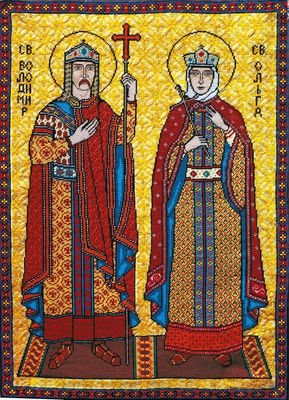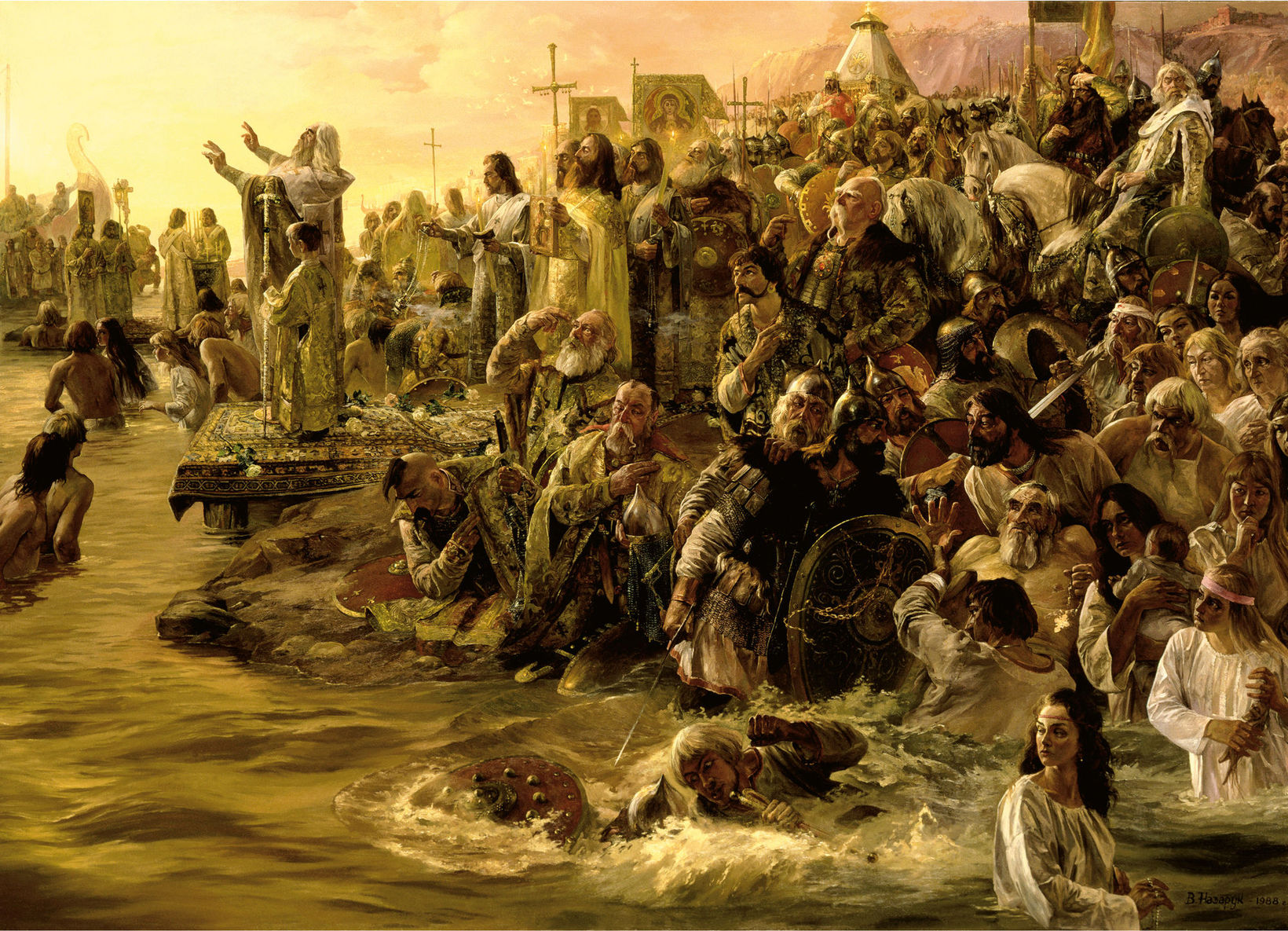3. Baptism of Rus’-Ukraine 988
 Saints Volodymyr and Olha. Embroidered Icon by Fr. Dmytro Blazheyovsky
Before Prince Volodymyr’s reign, Christianity had no official status in Rus’, although Kyivan princes, beginning from Askold, either themselves converted to Christianity or were tolerant of the Christian faith. For the year 944, during the reign of Prince Ihor (912–945), chronicles mention a St. Elijah church in Kyiv’s Podil district. Ihor’s wife, Princess Olha (945–969) was baptized in Constantinople circa 957 and subsequently maintained close contacts with the German Emperor Otto I, inviting German missionaries headed by Bishop Adalbert to visit Rus’ around 959.
Saints Volodymyr and Olha. Embroidered Icon by Fr. Dmytro Blazheyovsky
Before Prince Volodymyr’s reign, Christianity had no official status in Rus’, although Kyivan princes, beginning from Askold, either themselves converted to Christianity or were tolerant of the Christian faith. For the year 944, during the reign of Prince Ihor (912–945), chronicles mention a St. Elijah church in Kyiv’s Podil district. Ihor’s wife, Princess Olha (945–969) was baptized in Constantinople circa 957 and subsequently maintained close contacts with the German Emperor Otto I, inviting German missionaries headed by Bishop Adalbert to visit Rus’ around 959.
However, the decisive step for the future and identity of the Church in the East Slavic lands was the adoption of Christianity of the Eastern rite as the state religion in 988, during the reign of the grandson of Prince Ihor and Olha, Volodymyr the Great (978–1015).
While the Chronicle of Nestor reports that the Prince sent envoys to representatives of various religions and ultimately accepted Christianity, the decision was not accidental. Besides religious reasons, an important role in the adoption of Christianity was the political and cultural expediency of such a step, since Christianity played a key role in what was then the civilized part of the world. The adoption of Christianity ensured moral prestige for Prince Volodymyr and his state, giving it a legitimate status among other nations and rulers, and thereby changing their attitude towards Rus’. The baptism of the Eastern Slavs who lived within the Kyivan state at that time, facilitated the rapid spread of a written culture. Monasteries, where books were hand-copied with the purpose of rooting Christianity on Rus’ territory, were the core nuclei of this written culture.
The arrival in Kyiv of the Metropolitan from Constantinople marked the beginning of the history of the Kyivan Metropolia as a part of the Constantinople Patriarchate. At the same time, this ecclesiastical and jurisdictional dependence did not prevent Kyiv from maintaining contact with the Roman Apostolic See and the Latin West.
For Grand Prince Volodymyr, the formal baptism of Rus’ was not an end in itself. Having changed his ways (in his youth he was prideful and imperious, leading a reckless and bloody tyrannical life) he became engaged in the formal enlightenment of the masses. He built temples, supported literary crafts, founded libraries, and supported schools.
Volodymyr’s successor to the throne of Kyiv and his religious follower was Borys, the Prince of Rostov. Borys and his brother Hlib were murdered in 1015 by their elder step-brother Sviatopolk, later dubbed “the Damned”, who wanted to seize the throne.
The murdered brothers were the first officially canonized Ukrainian (Ruthenian) saints.
The Kyivan Metropolia enjoyed a golden age during the reign of another of Volodymyr’s sons, Yaroslav the Wise (1019–1054), when “the Christian faith began to multiply and spread.” The prince initiated the construction of Kyiv’s majestic monasteries and churches, completed construction of the Cathedral of St. Sophia, which had been commenced by his father. While strengthening the state from within through the development of education and science and the codification of laws based on Christian principles, Yaroslav the Wise established diplomatic relations with many European countries. In order to reinforce his influence on the hierarchical structure of the Church and foster greater independence of the Metropolia from Constantinople, in 1051 he initiated the election of Hilarion (a native of the region) as the Metropolitan of Kyiv.
 Picture “Baptism of Rus’.” Artist Viacheslav Nazaruk
Picture “Baptism of Rus’.” Artist Viacheslav Nazaruk
After the death of Metropolitan Hilarion, spiritual life was concentrated in the hands of Theodosius of the Caves, the Ukrainian founder of the code of monastic communal life, the hegumen and builder of the Kyiv-Pechersk Lavra, which had been founded by St. Anthony. Seeking to bring the monastic life into compliance with Eastern church traditions, Theodosius introduced the strict code of the monastery of St. Theodore the Studite. The monks wrote chronicles, wrote icons, and conducted debates on the major religious — and partly political issues.
The Kyivan Metropolia faced significant changes that occurred as a result of the gradual disintegration of the state into separate principalities and the violent struggle of the many descendants of the Rurik dynasty for the “Kyiv heritage.” After the invasion of the Mongol Horde in 1240, rulers from neighboring states joined the fight. In these circumstances, it was the Church that remained virtually the only solid social institution of ancient Rus’ amidst the disintegration and loss of political independence. The Church strengthened the idea of a common ethnic identity in people’s minds, which played an important role in the fight against absorption by other nations over the next few centuries.